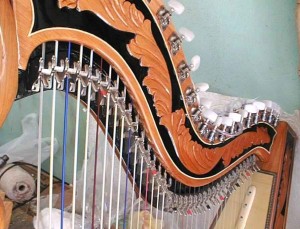 The city of Luque, Paraguay is part of the metropolitan area of Gran Asuncion and is infamous for several reasons. It’s the location of Paraguay’s Silvio Pettirossi International Airport and the home of CONMEBOL, the South American Football Association. But, Luque is also famous for it’s production of harps and other stringed instruments.
The city of Luque, Paraguay is part of the metropolitan area of Gran Asuncion and is infamous for several reasons. It’s the location of Paraguay’s Silvio Pettirossi International Airport and the home of CONMEBOL, the South American Football Association. But, Luque is also famous for it’s production of harps and other stringed instruments.
The harp is the official instrument of Paraguay and politicians, soccer teams and even social clubs are all recognized by the harp melodies that identify them. All along the road side that leads to the airport, there are numerous shops that sell harps and sidewalk vendors even have them leaning against walls waiting for passing tourists.
According to the famous harp maker, Lino Ruiz Diaz, Pablo Ramirez was responsible for the unique harp neck design that quickly became the standard neck on Paraguayan harps several decades ago. The neck is constructed with two halves of wood that are laminated, usually by the harp maker. And, the strings come from holes that are located in the center of the harp neck.
The resulting harp is symmetrical and has perfectly centralized pressure zones that allow the harp to have a light construction that isn’t achieved in any other type of harp. Modern versions of the harp are generally around five feet tall and will weigh some where between 7 and 12 pounds.
Most of the harps that are made in Luque have 36 strings, but some harp makers use up to 40 strings. The strings are spaced closer together than in other harps made in Latin America. The spacing gets wider toward the lower range on the harp to provide more room for string vibrations and the artists fingers.
The harps feature one single hole for sound in the bottom of the sound box, but sometimes there are one or more holes added to the back section of the sound box. Traditionally, all the tuning pegs were constructed from hard wood, but most modern harps now have tuning pegs that are made of aluminum. Some designers even use pegs that resemble guitar pegs.
Luque harps are one of the most popular in South American and are becoming one of the most popular in the world. Some harpists in Chile and Ecuador even choose Paraguayan harps for their performances. And, Paraguayan harps are now being manufactured in several other parts of the world including the U.S. and Europe.
The combination of the neck design and the placement of the strings create a really powerful sound. In fact, the sound from these harps is so amazing that some Celtic harp makers are now designing their instruments after the Paraguayan harp design.

{ 0 comments… add one now }